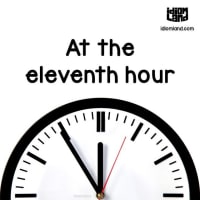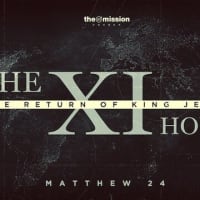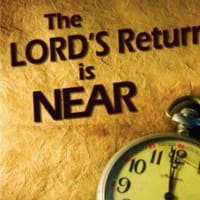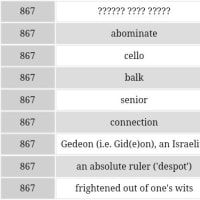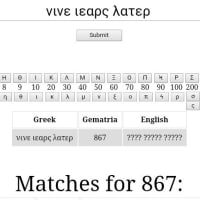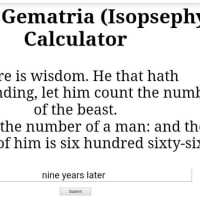艱難前 携挙 が間違っている理由を訳してみました。
今回は、【黙示録 4章以下に“教会”というコトバが存在しないから、艱難時代前に携挙されている】という艱難時代前説 に対する反論を紹介します。
牧師さんの前書き:
When I was pretrib it was not because I was a coward, it was because I sincerely believed Pretrib/Dispensationalism was the truth. A Post-trib now (for 25 years), I can say it is equally wrong when I hear insinuations that Post-tribs are foolhardy masochists. I know that isn’t so. I do not particularly relish the thought of suffering. Here’s where it all really comes down to - what does the Bible really say? It’s not a matter of what I want.
私も、初めは艱難前携挙説を信じましたが、別に怖がりだったからでもなく、その時は、艱難前携挙/ディスペンセーション主義が真実だと想い込んでいました。その後 25年間、艱難時代後 携挙説を信じています。“艱難時代後説”について、無謀で向こう見ずな考えを当てこすっている、と批判する声も耳にしますが、そうは思いません。 とは言っても、私だって、艱難期に試練を体験することを楽しみにしているわけではありません。でも、自分の願望ではなく、聖書に何が書かれているのかを教えることが、私の信念の根底にあります。
<艱難前 携挙説の主張>
The word "church" is found often in chapters 1 - 3, but is missing in the tribulation chapters.
「黙示録1-3章では、“教会”というコトバが引用されているけど、4章からは、“教会”というコトバが使われてないのは、艱難時代前携挙が起きて教会が取り去られているからです」
<上記の主張に対する反論>
However, this does not prove pretrib for the following reasons:
上記の理屈が艱難前携挙を立証する事にはなりません。その理由はこれらです:
■ The first thing that should strike us is Revelation has more detailed information about the tribulation than anywhere else in the Bible - why such detail addressed to those who are not supposed to be there? The entire Revelation is addressed to the church in chapters 1-3, common sense would dictate that Revelation is addressed to those who are supposed to be there
黙示録では艱難時代について、聖書の他のどの書より、とても詳細に説明されています。では、艱難時代前に世界中の信者がいなくなるのなら、どうして、そこまで詳細に説明する必要があるのですか?艱難時代の詳細について、ヨハネは1~3章の名前のリストにあるアジアの7つの教会に手紙を宛てたから○○教会と書かれているだけで、4章以下に固有の教会名や教会というコトバがないのは、4章からは、未来(私たちの世代)のクリスチャンに対してのメッセージなのです。
■ The church (the seven churches of Asia) is depicted on earth in chapters 1-3, and is supposed to be no longer on earth, but in heaven in chapters 4-19. The absence of the word "church" in the earthly scenes is supposed to prove the church is now in heaven. But this proves too much for the pretribs, it is a double edged sword. For in depictions of what's going on in heaven during the tribulation, 4:1 - 5:14; 7:9 - 8:5; 11:15 - 12:17; 14:1-5; 15:1-8; 19:1-10, "church" is not there either!. So, the pretrib inference is nullified, the non-mention of the church in heaven during the tribulation cancels out it's non-mention on earth.
アジアの7つの教会宛てに、この手紙が書かれた当時(1~3章)、これら教会は、まだ地上に存在していましたが、4~19章は未来の時代のことで、その頃には、これら教会は地上ではなく天国にいます。そういう理由で、4章以下は、アジアの教会の名前も“教会”というコトバも使われていません。 使徒ヨハネは、アジアの7つの教会に宛てて書きましたが、未来に起こる艱難期になると(4章以降)、アジアの7つの教会は地上に不在になることを念頭に、あなたたち“教会”という表現をしなかったのです。黙示録4:1-5:14; 7:9-8:5; 11:15-12:17; 14:1-5; 15:1-8; 19:1-10 の出来事が起こる時、アジアの7つの教会は既に天に上げられており、地上にいません。
■ Pretribs divide Revelation into very distinct sections: church (chapt. 1-3), tribulation (ch. 4-19), millennium (ch. 20), new heavens and earth (ch. 21 - 22:15), and conclusion (22:16-21).In the conclusion we find "churches:" "I Jesus have sent my angel to testify unto you these things in the churches" (22:16). Since this is at the end of the book, "these things" includes the tribulation, millennium, and new heaven and earth. Obviously, this verse is a summing up of "things" that pertain to the "churches." Why single out the tribulation because the word "church" is absent? It's NOT in the millennium and new heaven and earth section either! Does the Millennium and the new heaven and earth pertain to the church? If so, then so does the tribulation.
艱難前携挙説を支持する人は、黙示録の時期を以下のように章を別けて捉えた後、艱難時代期だけは教会に関係ないと例外にします。
1~3章:教会 / 4-19章:艱難時代 / 20章:1000年王国 / 21-22:15:新天地 / 22:16-21:結び
注意すべき視点は、最終章である黙示録22章、16節に、複数形の“教会”(churches)というコトバが使われています。
16 わたしイエスは、“これらすべて”を諸教会に知らせるため、あなたがたに使者を送りました。わたしはダビデの根であり、その子孫です。また、ひときわ輝く明けの明星です。
そして、22節には、“これらのこと”を知らせてくださった方が、はっきり宣言します。「そのとおり。わたしはすぐに戻って来ます。」アーメン。主イエスよ、来てください。
とあります。 黙示録22章(結びの章)に、“教会”というコトバが出てきます。また、“これら”(these things)とあります。“これら”が意味するのは、4~22章に描写されている艱難時代、1000年王国、新天地 で起きることの全てについてだということが明白です。そして、これら全てについての警告(アドバイス)が、諸教会に宛てられたという事です。ですので、“艱難時代”も教会に関係するのであり、艱難時代だけは例外で、“教会”に関係しないとは主張出来ません。艱難時代が教会に関係ないなら、それ以降の1000年王国や新天地と地上 についても教会に関係ないということになります。
■ A glaring example of the error of making a doctrine out of the non-mention of "church" is Rev. 19:7: "The marriage of the Lamb is come, and his wife hath made herself ready." We dare not exclude the church here because the word "church" is not there. Is not the church the bride of Christ? What we have here is proof that other words can be used besides "church."
黙示録19章7節に、さあ、大いに喜び楽しみ、神をほめたたえよう。小羊の結婚の時が来て、花嫁のしたくも整った。 という箇所では、“花嫁” (his wife)のしたく と書かれています。“キリストの花嫁”のはずである“教会”(church)というコトバが使われていないのは、教会が既に艱難時代前に消えているからだという説明を耳にしますが、この章では、どうして“花嫁”と表現されているのかは、婚礼の表現に、“教会の支度”とするより、“花嫁の支度”と表現したほうが文章的に意味が通るからです。聖書では、“教会”が、別のコトバでも表現されます。
■ In the first fifteen chapters of Romans, a vitally important doctrinal part of the NT, the word church is not there. And, it's not in the following books at all: Mark, Luke, John, 2 Timothy, Titus, 1 Peter, 2 Peter, 1 John, 2 John, and Jude! Yet, we all know these books are for the church (especially the epistles) - even though the word "church" may not be there. The church in the se books, and in the rest o Peter, 1 John, 2 John, and Jude! Yet, we all know these books are for the church (especially the epistles) - even though the word "church" may not be there. The church in these books, and in the rest of the NT, is spoken of as "saints," the "elect," God's "people," God's "Israel," true "Jews," Abraham's seed, "servants," the bride of Christ, etc. THE SAME IS TRUE FOR REVELATION.
ローマ書1~15章には、新約聖書の中でも、とても重要な教えが載っています。しかし、“教会”というコトバは1度も使われていません。マルコ、ルカ、ヨハネ、2テモテ、テトス、1ペテロ、1ヨハネ、2ヨハネ、ユダ 書においても使われていません。しかし、これら全ては教会に宛てられたものだというのは言うまでもないことです。特に書簡(the epistles)は、教会宛てだということが明白です。これらの新約聖書の書物の中に“教会”というコトバが1度も書かれてなくても、“聖徒”(saints)というコトバが使われています。もちろん、他の新約の書物にも“聖徒”、“選ばれし者”(the elect)、“神の民”(God's people)、“イスラ工ル”、“アブラハムの子孫”(Abraham's seed)、“キリストの体”(body of Christ)、エクレシア、“神の宮”(Temple of God)、“仕えるもの”(the servants)、“キリストの花嫁”(the bride of Christ) など、様々なコトバで“教会”が、表現されています。
■ "Saints" are definitely depicted in the tribulation in 13:7,10; 16:6; 17:6; 18:24, suffering at the hands of antichrist. Pretribs say, due to the usage of "saints" instead of "church," that this cannot be the church. But, that it is the church is manifest, for 19:7, 8 says: "Let us be glad and rejoice, and give honour to him: for the marriage of the Lamb is come, and his wife hath made herself ready. And to her it was granted that she should be arrayed in fine linen, clean and white: for the fine linen is the righteousness of the SAINTS." The bride, which all acknowledge to be the church, is arrayed in the righteousness of the SAINTS! The same "saints" Revelation depicts in the tribulation.
黙示録13:7-10, 16:6, 17:6, 18:24 には、艱難時代期の中での反キリストによる迫害が記載されています。“教会”ではなく、“聖徒“(saints)というコトバが使われていることに対し、携挙で取り上げられた“教会”ではなく、携挙で取り残された聖徒=クリスチャンに対する迫害のことであり、“教会”に対しての迫害ではないと主張していますが、黙示録19章には、このように書かれています。
7さあ、大いに喜び楽しみ、神をほめたたえよう。小羊の結婚の時が来て、花嫁 のしたくも整った。 8花嫁は、輝くばかりの、きよく真っ白な麻布の衣を着せられた。」この麻布は、聖徒の正しい行いを表しているのです。
これから判るのは、“花嫁”=“聖徒”のことであり、“聖徒”=“教会”のとこです。黙示録の艱難時代(現代)において、“聖徒”というコトバは、“教会”と同じ意味で使われているのです。
■ The non-mention of "church" in the tribulation section is a faulty inference. The book of Revelation is, after all, only addressed to the seven churches in the province of Asia minor, not to the church at Antioch, nor the church at Rome, etc. - NOT to the church in it's totality. To a provincial church, not to the general church. Thus, a word that designated the general church in the endtimes such as "saints" would naturally be used. ["Saints" is used of the church some 50 times in the epistles.] To symbolize more specific aspects of the church, the bride (Rev 19:7); and the 144,000 "servants of our God" (Rev 7:1-8; 14:1-4), which is God's Elect, God's Israel (the Israel of God, Gal. 6:16), are used.
艱難時代に“教会”というコトバが出てこないから、教会は既に携挙に預かっていると考えるのは、間違った推測です。
結局のところ、黙示録は、“アジアの7つの教会”だけに宛てられた手紙であり、アンテオケやローマの教会などには宛てられていません。全ての教会や一般の教会に宛てらたのではありません。アジアのある地方の教会に宛てられたのであり、その他全部の教会宛てではありません。ですので、アジアの7つの教会以外の、黙示録4章以降の終末時代に生きる教会の人たちについては、“聖徒”(saints)というコトバで呼んだのです。新約の書簡では、“聖徒”というコトバが50回程使われています。 他にも、黙示録19:7の“花嫁”(the bride)、黙示録7:1-8, 14:1-4にある14万4000人の“神の働き人=神に仕える者”(servants of our God)=“神の選ばれし者”、“神のイスラ工ル”(ガラテア6:16)などの詳細記述が、“教会”を象徴するシンボルです(別のコトバですが、全て教会のことを指します)。










